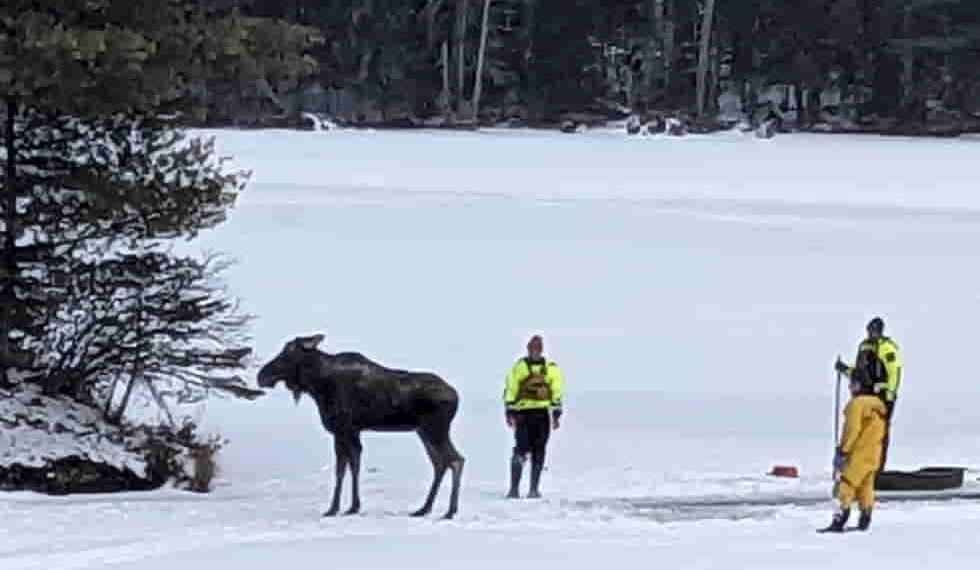First Responders Save Moose Stranded on Lake Ice in New York
A heroic cold-water rescue saved a bull moose that had fallen through the ice on Lake Abanakee in New York’s Adirondack Mountains. The moose, which fell around 11 a.m. Thursday, was located about 200 feet (60 meters) from shore. New York State Department of Environmental Conservation (DEC) conservation officers were quick to respond, executing a laborious rescue operation.
Rescue Operation Begins
The rescue effort started after a passerby witnessed the moose break through the ice and called it in. Lt. Robert Higgins, an Environmental Conservation Police officer, was dispatched to the scene. Realizing the situation’s complexity, Higgins called for backup, and soon forest rangers Evan Nahor and Matt Savarie joined him on site.
“There’s no training manual for getting moose out of the ice,” Lt. Higgins remarked, recalling the difficult operation in a video statement.
The Dangers of Ice Rescues
Moose, vulnerable to hypothermia after falling through ice, face a high risk of death in these situations. The massive animals struggle to climb out of icy waters, and rescuers face the danger of falling through the ice themselves.
“We were able to use our ice rescue training to safely get out there,” said Forest Ranger Evan Nahor, detailing how they prepared for the dangerous task.
The team wore dry suits to keep warm and float in case they fell into the water. They also carried a long metal “spud bar” to test the thickness of the ice, which ranged from one to four inches (2.5 to 10 centimeters) in some areas. Ropes were on hand for safety, to pull anyone out of the water in case of an emergency.
A Careful Strategy
The rescuers cautiously navigated the lake, finding the thickest paths to avoid breaking through. Kneeling on sleds helped distribute their weight across the ice. Once they reached the moose, the forest rangers used a chainsaw to cut ice sections connecting the thinner area where the moose fell through to thicker ice. Lt. Higgins worked to push the ice blocks under the channel to clear the way.
The goal was to guide the moose down the channel, allowing it to swim to safety. However, due to its immense size—around 1,000 pounds (455 kilograms)—pulling it out was not an option.
The Moose’s Fear of Sleds
While the plan was to herd the moose toward the thicker ice, the animal wasn’t easily intimidated by the rescuers. However, it had one notable fear: the sleds.
“For whatever reason, it was scared of those,” said Forest Ranger Matt Savarie. Once the rangers positioned themselves behind the moose, they successfully directed it toward the path they had cleared. The moose, frightened by the sleds, quickly crawled onto the solid ice.
Exhausted but Resilient
After about two hours of treading water and fighting the cold, the moose was exhausted. “It was really tired. I was shivering. It didn’t have much energy left,” Lt. Higgins said. The rescue team wasn’t sure if the moose would be able to stand.
But after 15 minutes of rest, the moose regained its strength and stood up. “It was just an amazing sight to see that huge moose stand up right in front of us,” Higgins recalled.
The moose, now on solid ground, walked off into the woods, leaving the rescuers in awe of the successful, life-saving effort.
A Heartwarming Rescue
This incredible rescue highlights the challenges faced by New York’s wildlife and the dedication of its conservation officers. While moose face threats from poaching, vehicle collisions, and the effects of climate change, this rescue was a reminder that, in some cases, humans can be their greatest allies.
This article was rewritten by JournosNews.com based on verified reporting from trusted sources. The content has been independently reviewed, fact-checked, and edited for accuracy, neutrality, tone, and global readability in accordance with Google News and AdSense standards.
All opinions, quotes, or statements from contributors, experts, or sourced organizations do not necessarily reflect the views of JournosNews.com. JournosNews.com maintains full editorial independence from any external funders, sponsors, or organizations.
Stay informed with JournosNews.com — your trusted source for verified global reporting and in-depth analysis. Follow us on Google News, BlueSky, and X for real-time updates.














